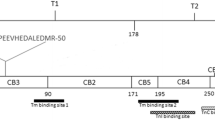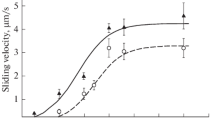Abstract
Certain heavy metal actions such as Cd2+ and Pb2+ mimic Ca2+ effectively in stimulating calmodulin (CaM). We now show that these cations also activate skeletal muscle troponin C (TnC), a Ca2+-binding protein highly homologous to CaM. Like Ca2+, these cations allow TnC to alter its electrophoretic mobility on polyacrylamide gels, and to bind to phenyl-Sepharose. Moreover, they activate TnC to stimulate myofibrillar ATPase. When TnC was removed from the skeletal myofibrils by treatment with trans-1,2-cyclohexanediamine-N,N,N',N'-tetraacetic acid (CDTA), the ATPase activity was no longer stimulated by the cations. However, after reconstitution of CDTA-treated skeletal myofibril with TnC, the response of ATPase to Ca2+, Cd2+ or Pb2+ was restored. These findings suggest that the activation of myofibrillar ATPase by Cd2+ and Pb2+ is mediated through TnC. The ability of the heavy metals to stimulate TnC-supported ATPase activity correlated quite well with the ability to increase the extent of the myofibrillar superprecipitation. The activation of TnC by Cd2+ or Pb2+ could constitute a possible molecular basis for their toxicity.
Similar content being viewed by others
References
Bradford MM (1976) A rapid and sensitive method for the quantitation of microgram quantities of protein utilizing the principle of protein-dye binding. Anal Biochem 72: 248–254
Chao SH, Suzuki Y, Zysk JH, Cheung WY (1984) Activation of calmodulin by various metal cations as a function of ionic radius. Mol Pharmacol 26: 76–82
Cheung WY (1984) Calmodulin: the potential role in cell proliferation and heavy metal toxicity. Fed Proc 43: 2995–2999
Collins JH, Greaser ML, Potter JM, Horn MJ (1977) Determination of the amino acid sequence of troponin C from rabbit skeletal muscle. J Biol Chem 252: 6356–6362
Dreisbach RH (1983) Handbook of poisoning: prevention, diagnosis and treatment, 11th ed. Lange Medical Publications, Los Altos, CA
Ebashi S, Endo M (1968) Calcium ion and muscle contraction. Prog Biophys Mol Biol 18: 123–183
Ellis PD, Strang P, Potter JD (1984) Cadium-substituted skeletal troponin C cadmium-113 NMR spectroscopy and metal binding investigations. J Biol Chem 259: 10348–10356
Ellis PD, Marchetti PS, Strang P, Potter JD (1988) Cadmium-substituted skeletal troponin C metal binding investigations and sequence assignment of the cadmium-113 resonances. J Biol Chem 263: 10284–10288
Evans JS, Levine BA, Leavis PC, Gergely J, Grabarek Z, Drabikowski W (1980) Proton magnetic resonance studies on proteolytic fragments of troponin C. Structural homology with the native molecule. Biochm Biophys Acta 623: 10–20
Fiske CH, Subbarow Y (1925) The colorimetric determination of phosphorus. J Biol Chem 66: 375–400
Forsen S, Thulin E, Lilja H (1979)113Cd NMR in the study of calcium binding proteins: troponin C. FEBS Lett 104: 123–126
Fuchs F (1971) Ion exchange properties of the calcium receptor site of troponin. Biochim Biophys Acta 245: 221–229
Fullmer CS, Edelstein S, Wasserman RH (1985) Lead-binding properties of intestinal calcium-binding proteins. J Biol Chem 260: 6816–6819
Goyer RA (1981) In: Broner F, Coburn JW (ed) Lead: Disorder of mineral metabolism, vol 1. Academic Press, New York, pp 160–199
Hai CM, Murphy RH (1988) Sr2+ activate cross-bridge phosphorylation and latch state in smooth muscle. Am J Physiol 255: C401-C407
Head JF, Perry SV (1974) The interaction of the calcium binding protein (troponin C) with bivalent cations and the inhibitory protein (troponin I). Biochem J 137: 145–154
Johnson JD, Potter JD (1978) Detection of two classes of Ca2+ binding sites in troponin C with circular dichroism and tyrosine fluorescence. J Biol Chem 253: 3775–3777
Kopp SJ, Prentice RC, Perry HM (1985) Effects of low lead and cadmium exposure on blood pressure and myocardial function and metabolism. Adv Mod Environ Toxicol 9: 173–195
Klee CB, Vanaman TC (1982) Calmodulin. Adv Protein Chem 35: 213–321
Laemmli UK (1970) Cleavage of structural proteins during the assembly of the head of bacteriophage T4. Nature 227: 680–685
Leavis PC, Gergely J (1984) Thin filament proteins and thin filament-linked regulation of vertebrate muscle contraction. CRC Crit Rev Biochem 16: 235–305
Leavis PC, Nagy B, Lehrer SS, Bialkowska H, Gergely (1980) Terbium binding to troponin C: binding stoichiometry and structural changes induced in the protein. Arch Biochem Biophys 200: 17–21
MacNeil S, Dawson R, Lakey T, Morris B (1987) Activation of calmodulin by the essential trace element chromium. Cell Calcium 8: 207–216
Markovac J, Goldstein GW (1988) Picomolar concentrations of lead stimulate brain protein kinase C. Nature 334: 71–73
Mazzei GJ, Girard PR, Kuo JF (1984) Environmental pollutant Cd2+ biphasically and differentially regulates myosin light chain kinase and phospholipid/Ca2+-dependent protein kinase. FEES Lett 173: 124–128
Morimoto S, Ohtsuki I (1987) Ca2+- and Sr2+-sensitivity of the ATPase activity of rabbit skeletal myofibrils: effect of the complete substitution of troponin C with cardiac troponin C, calmodulin, and parvalbumins. J Biochem 101: 291–301
Nagy B, Gergely J (1979) Extent and localization of conformational changes in troponin C caused by calcium binding. J Biol Chem 254: 12732–12737
Niewenhuis RJ, Prozialeck WC (1987) Calmodulin inhibitors protect against cadmium-induced testicular damage in mice. Biol Reprod 37: 127–133
Ohtsuki I, Maruyama K, Ebashi S (1986) Regulatory and cytoskeletal proteins of vertebrate skeletal muscle. Adv Protein Chem 38: 1–67
Perrino BA, Chou IN (1986) Role of calmodulin in cadmium-induced microtubule disassembly. Cell Biol Int Rep 10: 565–573
Perry SV, Grey TC (1956) A study of the effects of substrate concentration and certain relaxing factors on the magnesium-activated myofibrillar adenosine triphosphatase. Biochem J 64: 184–192
Potter JD (1982) Preparation of troponin and its subunits. Methods Enzymol 85: 241–263
Potter JD, Gergely J (1975) The calcium and magnesium binding sites on troponin and their role in the regulation of myofibrillar adenosine triphosphatase. J Biol Chem 250: 4628–4683
Potter JD, Johnson JD (1982) Troponin. In: Calcium and cell function, vol 2. Academic Press, New York, pp 145–173
Rice RV, Asai H, Morales M (1963) Conformational changes in myosin B and actomyosin induced by ATP. Biochemistry 50: 549–557
Richardt G, Federolf G, Habermann E (1986) Affinity of heavy metal ions to intracellular Ca2+-binding proteins. Biochem Pharmacol 35: 1331–1335
Sagara J, Nishimura Y, Yamada T (1984) Superprecipitation of actomyosin with p-chloromercuribenzoate modified myosin reconstituted from rabbit skeletal muscle. J Biochem 96: 1027–1031
Satyshur KA, Rao ST, Pyzalska D, Drendel W, Greaser M, Sundaralingam M (1988) Refined structure of chicken skeletal muscle troponin C in the two-calcium state at 2-A resolution. J Biol Chem 263: 1628–1647
Simons JJB (1986) Cellular interactions between lead and calcium. Br Med Bull 42: 431–434
Sneddon J (1987) Action of di- and tri-valent cations on calcium-activated K+-efflux in rat erythrocytes. Biochem Pharmacol 36: 3723–3730
Sotiroudis TG (1986) Lanthanide ions and Cd2+ are able to substitute for Ca2+ in regulating phosphorylase kinase. Biochem Int 13: 59–64
Stephenson DG, Thieleczek R (1986) Activation of the contractile apparatus of skinned fibers of frog by bivalent cations, barrium, cadmium and nickel. J Physiol 380: 75–92
Suzuki Y, Chao SH, Zysk JH, Cheung WY (1985) Stimulation of calmodulin by cadmium ion. Arch Toxicol 57: 205–211
Verbost PM, Flik G, Lock RAC, Bonger SEW (1988) Cadmium inhibits plasma membrane calcium transport. J Membr Biol 102: 97–104
Wang CLA, Leavis PC, Horrocks WD, Gergely J (1981) Binding of lanthanide ions to troponin C. Biochemistry 20: 2439–2444
Yamamoto K (1983) Sensitivity of actomyosin ATPase to calcium and strontium. Effect of hybrid troponins. J Biochem 93: 1061–1069
Author information
Authors and Affiliations
Rights and permissions
About this article
Cite this article
Chao, S., Bu, C.H. & Cheung, W.Y. Activation of troponin C by Cd2+ and Pb2+ . Arch Toxicol 64, 490–496 (1990). https://doi.org/10.1007/BF01977632
Received:
Accepted:
Issue Date:
DOI: https://doi.org/10.1007/BF01977632




